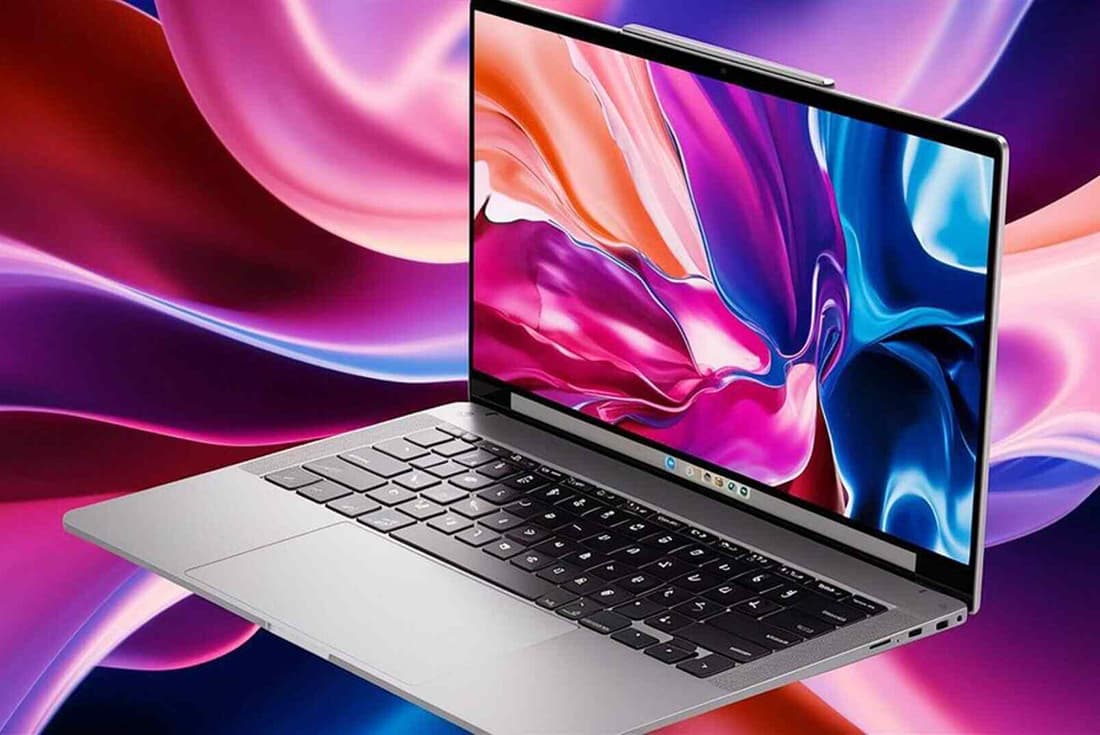
01 Oct The Burn-In Dilemma: Are OLED Laptops Worth the Risk?
OLED laptops have burst onto the scene, captivating us with their stunning visuals. Their ability to produce perfect blacks, vibrant colors, and infinite contrast ratios is truly mesmerizing. But this leap forward in display technology comes with a caveat. Along with the potential for incredible image quality, OLED laptops also bring the risk of burn-in, one of the most concerning laptop screen issues users might face.
OLED: The Game-Changer
Before we dive into the intricacies of burn-in, let’s take a moment to understand what makes OLED so special. OLED, or Organic Light-Emitting Diode, is a display technology that generates light at the pixel level. Unlike traditional LCDs, which rely on a backlight, each OLED pixel emits its own light. This fundamental difference unlocks a world of advantages.
OLED delivers perfect blacks, as pixels can be completely turned off, resulting in true darkness that LCDs can’t replicate. With perfect blacks and bright whites, OLEDs achieve an infinite contrast ratio, delivering images with incredible depth and realism. OLEDs also boast a wider color gamut than most LCDs, showcasing a richer and more lifelike spectrum of colors. Additionally, OLED pixels react faster than LCDs, minimizing motion blur and ghosting, a benefit for gaming and fast-paced content. Finally, since OLED pixels only illuminate when needed, they consume less power than backlit LCDs, potentially extending battery life. OLED panels are also incredibly thin, allowing for slimmer and lighter laptop designs.
The Rise of OLED in Laptops: Why Now?
While OLED has been a staple in high-end smartphones and TVs for years, its adoption in laptops has been slower. So, why are laptop makers suddenly embracing OLED?
Technological advancements in OLED manufacturing have led to improved yields and lower costs, making them more viable for laptops. As consumers experience OLED’s visual brilliance on other devices, they’re increasingly demanding it in their laptops. Laptop manufacturers are constantly seeking ways to differentiate their products, and OLED’s superior image quality offers a compelling selling point. With the rise of high-dynamic-range (HDR) content, OLED’s capabilities are becoming even more relevant.
In short, OLED represents a significant leap forward in laptop display technology. It’s no wonder that laptop makers are eager to harness its power. However, as with any new technology, there are potential drawbacks to consider.
Laptop Troubles? We Can Help!
Is your laptop giving you grief? Whether it’s a cracked screen, a sticky keyboard, or a system that’s slower than a snail, Downtown Computer Services can get you back on track. We’ve been fixing computers since 1995, so we’ve encountered (and solved!) just about every laptop problem imaginable.
Our experienced technicians can handle everything from simple laptop screen repair to complex upgrades. Bring your machine to our friendly team, and we’ll have you up and running in no time. Dial now: (954) 524 9002.
Burn-in
Burn-in, the dreaded specter that haunts OLED displays, is a phenomenon where static elements like icons or taskbars leave a permanent, ghostly imprint on the screen. Imagine the faint outline of your battery icon lingering even after you’ve closed your laptop, or the ghost of a channel logo etched onto your TV screen. Not exactly the picture-perfect experience you were hoping for, right?
But what causes burn-in, and why is it particularly prevalent in OLEDs?
At its core, burn-in is a consequence of the organic materials used in OLED displays. These organic compounds degrade over time, and the rate of degradation varies depending on the brightness and duration of light exposure. When a static image remains on the screen for extended periods, the pixels displaying that image work harder than others, leading to uneven wear and tear.
Think of it like a marathon runner pushing their body to the limit. While the rest of the runners take breaks and pace themselves, this dedicated athlete keeps going, eventually becoming exhausted and unable to perform at the same level as their peers. Similarly, the overworked pixels in an OLED display gradually lose their luminance and color accuracy, creating a persistent shadow or “burn-in” of the static image.
So, why are OLEDs more susceptible to burn-in than LCDs?
LCDs, with their backlight and liquid crystal layer, distribute light more evenly across the screen. Even if a static image is displayed, the backlight remains constant, minimizing the stress on individual pixels. OLEDs, on the other hand, rely on each pixel to produce its own light. This self-emissive nature, while responsible for OLED’s superior contrast and color accuracy, also makes them more vulnerable to burn-in.
In essence, burn-in is a trade-off for OLED’s exceptional image quality. It’s a reminder that even the most advanced technology has its limitations. But fear not, for while burn-in is a real concern, it’s not an inevitable fate for OLED displays. With proper care and mitigation techniques, you can significantly reduce the risk and enjoy the visual splendor of OLED without the haunting presence of burn-in.
Preventing Burn-In on OLED Laptops
While the threat of burn-in is real, it’s not an unavoidable doom for your OLED laptop. Thankfully, laptop manufacturers have armed themselves with an arsenal of clever technologies and software solutions to combat this issue.
Software Saviors
Many laptops now come equipped with specialized software designed to minimize the risk of burn-in. These intelligent programs employ a combination of techniques to keep your OLED screen healthy:
- Pixel Refresh feature acts as a digital rejuvenator, periodically refreshing the screen to ensure all pixels are evenly exercised. Think of it as a mini-workout for your display, keeping those pixels limber and preventing them from getting “stuck” in a static state.
- Pixel Shift is effective technique that involves imperceptibly shifting the screen content by a few pixels every now and then. By subtly altering the position of static elements, Pixel Shift ensures that no single pixel is subjected to constant stress, distributing the workload and reducing the likelihood of burn-in.
These software solutions work diligently behind the scenes, proactively protecting your OLED screen without interrupting your workflow. This kind of computer maintenance and support is essential for prolonging your laptop’s life.
Windows to the Rescue
Your operating system also plays a crucial role in preventing burn-in. Windows offers a range of settings that can help prolong the life of your OLED display:
- Enabling dark mode not only reduces eye strain but also minimizes the stress on OLED pixels, as they emit less light when displaying darker colors.
- Configure your laptop to automatically turn off the display when not in use. This simple step prevents static elements from lingering on the screen for extended periods.
- Adjust the screen brightness to a comfortable level. While OLED’s high brightness is tempting, consistently running it at maximum intensity can accelerate pixel degradation.
- Utilize a screensaver with moving elements to prevent static images from remaining on the screen for too long. Opt for a screensaver with a dark background to further minimize pixel stress.
- Consider auto-hiding the taskbar to reduce the constant strain on the pixels displaying those static icons.
By tweaking these settings, you can create a burn-in-resistant environment for your OLED laptop.
Built-in Burn-in Refinement
Some laptops even feature built-in burn-in refinement technology. This intelligent system continuously monitors the screen for signs of aging or less radiant pixels, automatically adjusting their brightness and hue to maintain image fidelity.
With these preventative measures in place, you can confidently enjoy the visual feast of OLED without constantly worrying about the dreaded burn-in. Remember, a little proactive care goes a long way in preserving the pristine beauty of your OLED screen.
The OLED Conundrum: Weighing the Pros and Cons
So, are OLED laptops worth the risk? The answer, as with most things in life, is nuanced.
The pros:
- OLED’s picture quality is simply unmatched.
- OLED panels are incredibly thin, allowing for slimmer and lighter laptops.
The cons:
- The potential for burn-in is a real concern.
- OLED laptops typically command a higher price tag.
- While improving, OLED longevity still lags behind traditional LCDs.
So, if you crave the absolute best in visual quality and are willing to take precautions against burn-in, then an OLED laptop might be your perfect match. However, if you prioritize longevity and budget-friendliness, a traditional LCD might be the safer bet.
Conclusion
In this post, we explored the dazzling world of OLED laptops, delving into their strengths, weaknesses, and the looming threat of burn-in. We examined the causes of burn-in and discovered how manufacturers and software developers are fighting back with innovative solutions to mitigate this risk. Ultimately, the decision of whether to embrace OLED technology comes down to your individual needs and priorities.
If you’re captivated by OLED’s visual brilliance and are willing to take proactive steps to prevent burn-in, then an OLED laptop might be your perfect match. But if longevity and budget-friendliness are paramount, a traditional LCD may be the safer bet.
And if you have any problems with your laptop, come to Downtown Computer Services. Call us at (954) 524 9002 and let’s bring your laptop back to life!
Key Takeaways
- OLED laptops offer unparalleled visual quality, but the risk of burn-in requires proactive measures to protect your investment.
- Software features like Pixel Refresh and Pixel Shift, along with Windows settings adjustments, can significantly reduce the risk of burn-in.
- Weighing the pros and cons of OLED against your needs and priorities is crucial in making an informed purchasing decision.
Check out other relevant news
- How Easy-to-Use Hacking Tools Are Fueling Cybercrime
- Cryptocurrency Security for Small Businesses: Protecting Your Wallet
- The Infostealer Epidemic: Protecting Your Business from the Latest Wave of Cyberattacks
- The Identity Crisis: How Compromised Credentials Can Cripple Your Business
- Beyond the Brick and Mortar: Building Your Online Storefront with Digital Marketing
